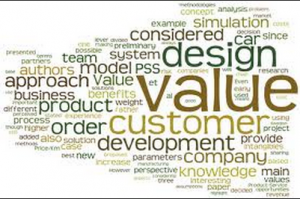Last week, I talked about common misconceptions on the meaning of corporate strategy. This week, I want to provide of few elements that will help defining what corporate strategy really means.
Defining strategy starts with understanding one’s environment. And, while most people believe that understanding your environment means understanding what your competitors are doing, I would argue that a company’s environment is not only limited to competitors, but also includes suppliers, clients, substitution products, and the threat of new entrants. Each player is trying to capture the value that the entire industry is creating. The the object of competition is not market share, size, or worldwide presence; the object of competition is capturing industry created value, which, itself, determines corporate profitability. So the first question is: who’s capturing industry created value?
In some industries, suppliers are capturing a large share of industry created value. In the PC industry, it’s estimated that Microsoft, a supplier of the PC industry with its Windows operating system, is capturing up to 60% of PC industry value. That’s an amazing figure. It basically means that for every dollar that PC clients are spending on getting new PCs, Microsoft is taking up to 60% of the value. That’s not the say that it’s taking $.60, but it does imply that it’s taking 60% of all industry generated profits.
In some other industries, clients, not suppliers, are taking the lion share of industry created value. Carlos Ghosn, the CEO of French manufacturing automobile Renault, has claimed that the European market is the most competitive market in the world. This intense competition among automobile manufacturers is bringing prices down and lowering profits for automobile company companies. According to Mr. Ghosn, automobile clients are capturing European automobile industry created value in the form of lower prices.
In the airline industry, substitution products are getting a large share of value, especially for short distances. In fact, as Europe is modernizing its railway system and creating more and more high-speed railways, we see a significant decline in short Airline flights. French High-Speed train connecting Paris to Marseille is a powerful substitute to a Paris-Marseille flight. Similarly, High-Speed train connecting Paris to Strasbourg has led Air France, a leading European Airline Company, to develop its own high speed train connecting Paris to Strasbourg. In Spain, when the high speed train connecting Madrid to Barcelona was introduced, there has been a dramatic shift from flights to train rides. The Economist reports that “in its first ten months the high speed train carried 2m passengers; in 2008 its share of the total market rose from 28% to 38%”. The Economist adds that “Josep Valls, of the ESADE business school, predicts that trains will carry most long-distance travelers by 2010”.
Finally, many analysts believe that substitution products, such as Smart Phones, are killing the Digital Camera market. Smart Phones, such as the iPhone and the Samsung Galaxy may take pictures of comparable quality to low-end Digital Cameras. The only viable market segment in the Digital Camera industry is the high-end market segment, which appeals to photography professionals. So, in this case, substitution products are capturing so much Digital Camera industry value that they may kill an entire market segment completely.

To sum up, the first step of any strategy is to map out all different players in your respective industry and identify who is taking industry created value and how they’re able to capture it.
- Suppliers, such as Microsoft and Intel, capturing PC industry value because they have created very high barriers to entry in their business. Microsoft has basically built a monopoly on operating systems; while Intel, investing heavily in innovation, has deterred many but AMD from entering the capital intensive microprocessor industry.
- Clients are capturing most of the industry created value in automobiles because of intense rivalry among European automobile players. The High Speed Railway is capturing value in the short Air Flight market segment because it offers a different value than flying: consumers are willing to pay a price premium for city to city transportation.
- Finally, substitution products in the Digital Camera industry are capturing so much value in the low-end part of the market segments that may end up killing the low-end Digital Camera industry entirely.
Next week, I’ll talk about positioning your company in the most favorable area in your industry; that is where it’s easiest to capture industry-created value. Critical to this positioning is building a tailored value chain.
What’s your competitive environment like? Who’s taking industry-created value? How are they able to secure their position over time? And what could you do to get a larger share of industry value?
Further Readings:
- For a presentation of how to map industry forces, please refer to 1998 HBR article, entitled “How to Map Your Industry’s Profit Pool?”
- For a discussion on how the AVE is substitution to Air Flights in Spain, please refer to Joan Magretta’s Understanding Michael Porter
- For a presentation of the 5 force framework, please refer to Michael Porter’s Competitive Advantage, chapter 1; for a summary, please refer here

[…] Strategy starts by understanding your environment, identifying where industry value is being created and who's capturing it. […]